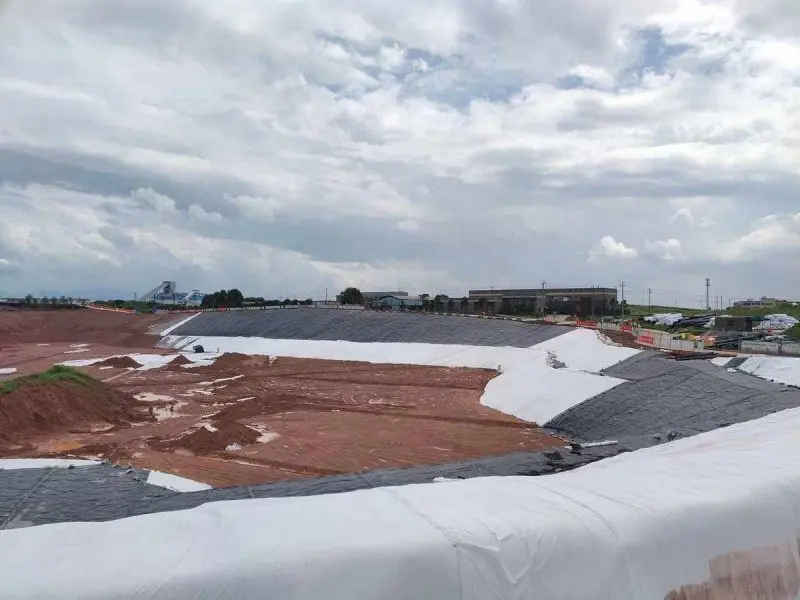![]() 300g PET geotextiles test report.pdf
300g PET geotextiles test report.pdf
Using geotextiles in road construction has become a common practice due to their ability to enhance the performance and longevity of roads. Geotextiles are synthetic materials specifically engineered for various geotechnical applications. In road construction, geotextiles offer several benefits, including soil stabilization, filtration, drainage, and separation of different soil layers. Here's a comprehensive guide on how to use geotextiles in road construction:
587514.webp)
Soil Stabilization: Geotextiles can be used to stabilize the soil beneath the road surface, improving its load-bearing capacity and reducing the risk of settlement. This is particularly useful in areas with weak or unstable soils.
Filtration: Geotextiles act as a filter to prevent the migration of fine particles from the subgrade into the base and pavement layers. This helps maintain the structural integrity of the road and prevents clogging of drainage systems.
915044.webp)
Drainage: Geotextiles facilitate efficient drainage by allowing water to pass through while preventing the loss of soil particles. They can be installed as drainage composites or wrapped around perforated pipes to improve the performance of subsurface drainage systems.
Separation: Geotextiles are used to separate different soil layers, such as subgrade soil from aggregate base or subbase materials. This prevents mixing and contamination of soil layers, which can compromise the stability and performance of the road.
700342.webp)
Erosion Control: Geotextiles help control soil erosion by stabilizing slopes, embankments, and roadside ditches. They prevent soil particles from being washed away by rainfall or surface runoff, preserving the integrity of the road infrastructure.
Pavement Reinforcement: In some cases, geotextiles are used to reinforce asphalt or concrete pavements, reducing cracking and extending the lifespan of the road surface. They distribute loads more evenly, thereby reducing stress concentrations and preventing premature pavement failure.

Construction of Unpaved Roads: Geotextiles can be used in the construction of unpaved roads to improve their stability, reduce dust generation, and minimize maintenance requirements. They provide a stable platform for vehicles and prevent the loss of fines from the road surface.
Installation Process: The installation of geotextiles in road construction typically involves placing the material directly onto the prepared subgrade or layer of aggregate base. It should be installed with sufficient overlap and secured in place to prevent displacement during subsequent construction activities.
765232.webp)
Quality Control: Regular inspection and quality control measures should be implemented during the installation of geotextiles to ensure proper placement, alignment, and coverage. Any damage or defects should be addressed promptly to maintain the effectiveness of the geotextile.
Long-Term Monitoring: After construction, ongoing monitoring of the road performance and condition of the geotextiles is essential to identify any issues or deterioration early on. This allows for timely maintenance or replacement as needed to extend the service life of the road.

In conclusion, the use of geotextiles in road construction offers numerous benefits in terms of soil stabilization, filtration, drainage, separation, erosion control, and pavement reinforcement. By following proper installation practices and conducting regular maintenance, geotextiles can significantly improve the durability and performance of road infrastructure.
Guidelines for Using Geotextile in Road Construction
Proper Selection: Ensure the appropriate type of geotextile is selected based on the specific requirements of the road construction project, including traffic load, soil characteristics, and environmental conditions.
Installation Procedures: Follow manufacturer recommendations and industry best practices for installing geotextile materials. Proper installation methods are crucial for achieving desired performance and longevity.
Site Preparation: Prepare the roadbed properly before placing geotextile materials. This includes ensuring proper grading, compaction, and removal of any debris or organic materials that could compromise the effectiveness of the geotextile.
Overlap and Seaming: Ensure proper overlap and seaming of geotextile rolls to prevent gaps or discontinuities that could compromise the integrity of the road structure. Use appropriate seaming techniques recommended by the manufacturer.
Protection During Construction: Take measures to protect geotextile materials from damage during construction activities, such as placing protective layers or barriers to prevent punctures or tears.
Quality Control: Implement quality control measures to monitor the placement and performance of geotextile materials during construction. This may include regular inspections and testing to ensure compliance with specifications.
Integration with Other Materials: Coordinate the installation of geotextile materials with other road construction materials, such as aggregate base layers or asphalt pavement, to ensure proper integration and compatibility.
Long-Term Monitoring: Establish a plan for long-term monitoring of the road section where geotextile materials have been used. This may include periodic inspections to assess performance, identify any issues, and plan for maintenance or repairs as needed.
Environmental Considerations: Consider the environmental impact of using geotextile materials in road construction, including potential issues related to disposal at the end of the road's lifecycle. Explore environmentally friendly options and disposal methods where feasible.
Documentation and Reporting: Maintain detailed documentation of geotextile installation procedures, inspections, testing results, and any deviations from the planned construction process. This information can be valuable for future reference and for informing improvements in road construction practices.
By adhering to these guidelines, road construction projects can effectively utilize geotextile materials to improve the performance, durability, and sustainability of the roadway infrastructure.
920.webp)
897.webp)
942.webp)
237.webp)